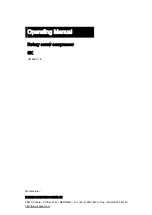
: JGW, JGR
AND
JGJ
S
ECTION
3 - S
TART
U
P
PAGE 3 - 8
Filling Sump & Priming a Main Oil Lube Oil System -
Before Starting
Filling The Sump
1.
Remove breather and fill compressor sump through top cover.
2.
Check sight glass on auxiliary end. Oil level at start-up should be near the top of
the glass. DO NOT OVERFILL SUMP. The crankshaft will dip into the oil, caus-
ing aeration and foaming, and making it difficult to pump and to control the
proper level. After the machine is running, it may be necessary to add oil to bring
up oil level to one-half the height of the sight glass; but it must never exceed
two-thirds height, while running.
3.
When the sump is filled to the proper level, replace and snug up the breather
cap by hand, to facilitate later removal.
Priming - Main Lube Oil System
NOTE: BE SURE THE OIL SYSTEM FROM THE LUBE OIL PUMP THRU THE COOLER
AND OIL FILTER IS FILLED WITH OIL.
JGW, JGR and JGJ frames are equipped with a manual lube oil priming pump. It is
important to prime the unit until the bearings receive oil. Five strokes of the pump,
after the pressure gauge at the oil filter outlet indicates pressure, is sufficient. If the
unit is equipped with a motor-driven pre-lube pump, the pump should run at pressure
for a minimum of fifteen seconds before starting the unit.
All electric motor driven compressors and all unattended start compressors with any
type driver must have a separate motor-driven prelube pump to ensure oil flow prior
to start-up. The prelube pump flow rate should be 50% of the flow rate of the com-
pressor frame lube oil pump. A start permissive for these applications is to be used to
disable the startup sequence if oil pressure is below 15 psig (1.0 bar
g
).
NOTE: IF THE CRANKSHAFT SPEED IS LESS THAN 50%, THERE WILL NOT BE
ENOUGH FLOW THRU THE PUMP TO MAINTAIN PROPER LUBE OIL PRES-
SURE TO THE FRAME. AN AUXILIARY OR A LARGER LUBE OIL PUMP WILL
BE REQUIRED.
Force Feed Lubricator Adjustment
Ensure that the force feed lubricator is set at the break-in rate shown on the force
feed lubricator plate (see Figure 1-5: on page 1-6). The break-in and normal lube tim-
ing rates that are stamped on the lubricator box information plate are calculated
according to the Ariel Lube Specifications to match the gas operation conditions as
supplied to Ariel with the compressor order. The lube sheets supplied in the Ariel
Parts Book state gas conditions and list the base rate multiplier at each lube point.
When gas conditions are not supplied, the rates are calculated for clean, dry, 0.65
specific gravity, sweet gas at rated speed and discharge pressures. An indicator on
Summary of Contents for JGJ Series
Page 30: ...FOR MODELS JGW JGR AND JGJ SECTION 1 DESIGN SPECIFICATIONS DATA PAGE 1 24 1 01 NOTES ...
Page 34: ...FOR MODELS JGW JGR AND JGJ SECTION 2 INSTALLATION PAGE 2 4 1 01 NOTES ...
Page 44: ...FOR MODELS JGW JGR AND JGJ SECTION 3 START UP PAGE 3 10 1 01 NOTES ...
Page 114: ...FOR MODELS JGW JGR AND JGJ SECTION 5 MAINTENANCE PAGE 5 42 1 01 NOTES ...
Page 120: ...FOR MODELS JGW JGR AND JGJ SECTION 6 TECHNICAL ASSISTANCE PAGE 6 6 1 01 NOTES ...
Page 130: ...FOR MODELS JGW JGR AND JGJ SECTION 7 APPENDICES PAGE 7 10 1 01 NOTES ...
Page 135: ......
Page 136: ......
Page 137: ......
Page 138: ......
Page 139: ......
Page 140: ......
Page 141: ......
















































